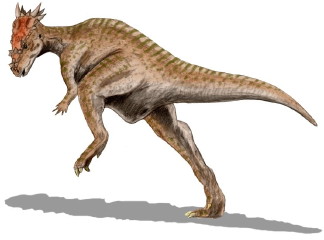Fewer dinosaur species and metaplastic bone
 There may have been a lot fewer dinosaur species than we thought. New research by paleontologists Mark Goodwin and Jack Horner reclassifies two pachycephalosaurid (dome-headed) dinosaurs, Dracorex hogwartsia (pictured; named for the Harry Potter books) and Stygimoloch spinifer, as juvenile forms of Pachycephalosaurus. A number of other dinosaurs have recently been reclassified or proposed as juvenile or elderly individuals of other species, including Nanotyrannus lancensis, which might be a juvenile of some other tyrannosaurid, and Torosaurus, which last month was reclassified as an elderly Triceratops.
There may have been a lot fewer dinosaur species than we thought. New research by paleontologists Mark Goodwin and Jack Horner reclassifies two pachycephalosaurid (dome-headed) dinosaurs, Dracorex hogwartsia (pictured; named for the Harry Potter books) and Stygimoloch spinifer, as juvenile forms of Pachycephalosaurus. A number of other dinosaurs have recently been reclassified or proposed as juvenile or elderly individuals of other species, including Nanotyrannus lancensis, which might be a juvenile of some other tyrannosaurid, and Torosaurus, which last month was reclassified as an elderly Triceratops.
Hold on — Torosaurus? How does that work? I thought Triceratops had a solid frill and Torosaurus had an open frill. How could Torosaurus be the same species with those big holes? The answer is metaplastic bone. From the ScienceDaily article:
[T]he so-called metaplastic bone on the heads of horned dinosaurs grows and dissolves, or resorbs, throughout life like no other bone, Horner said, and is reminiscent of the growth and loss of horns today in elk and deer. In earlier studies, Horner and Goodwin found dramatic remodeling of metaplastic bone in Triceratops, which led to their subsequent focus on dome-headed dinosaurs.
“Metaplastic bones get long and shorten, as in Triceratops, where the horn orientation is backwards in juveniles and forward in adults,” Horner said. Even in older specimens, such as the fossil previously named Torosaurus, bone in the face shield resorbs to create holes along the margin.
Metaplastic bone presumably also explains the morphological changes in the pachycephalosauria. Bottom line: dinosaur bone development may well have been quite different from what we’re used to — which makes figuring out which dinosaur was which from the bones a lot harder.
(Illustration by Wikipedia user ArthurWeasley.)